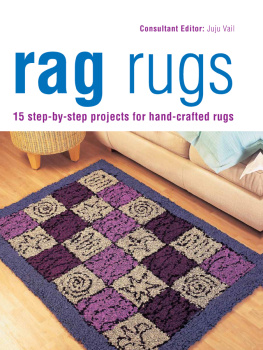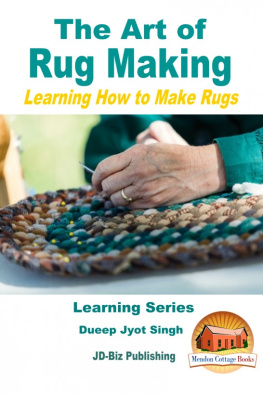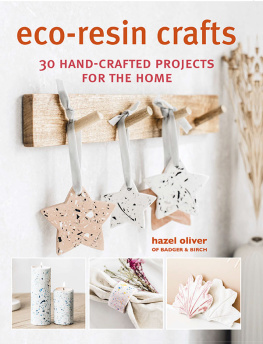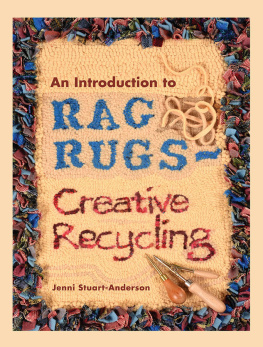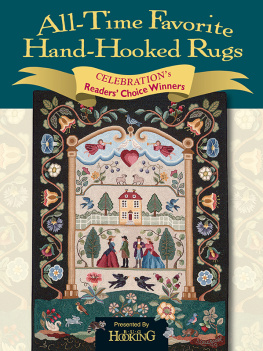Contents
Guide
rag rugs
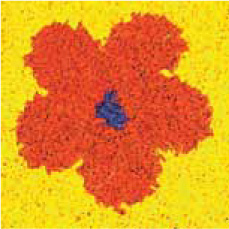

rag rugs
15 step-by-step projects for hand-crafted rugs
Consultant Editor: Juju Vail
Contents
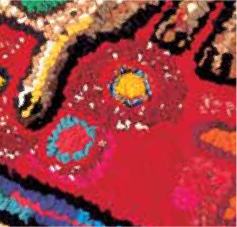

Projects

INTRODUCTION
The rug is one of the first things we look at when we come into a room. It plays a pivotal role in any decoration scheme and its colour pattern and texture can be used to set design themes. Its shape can also influence the way you use a room, designating different areas and directing the flow of traffic. Yet it is difficult to find exactly the shape, colour; size and pattern that will provide the kind of impact that you desire without having a rug custom made at an exorbitant price. By making a rug yourself, you can have control over all the design elements. Moreover; if you make your rug out of rags, it will cost you hardly anything at all.
Rag-rug making is a traditional craft. In Britain and North America the techniques that were most commonly used were hooking, prodding, braiding and weaving. These methods are now enjoying a revival, inspired partly by the desire to transform recycled materials into unique, hand-crafted pieces for the home.
There is much speculation about whether the technique of hooking and prodding rags through hessian began in Britain and was brought to North America by settlers, or whether it originated in North America. Hessian was first imported to Britain and North America in around 1 850, and the oldest surviving examples of hooked rag rugs, dating from about this time, come from the eastern United States and from Quebec and the Maritime Provinces of Canada. Earlier examples have, however, been found in North America; in these rugs, linen with some of its warp and weft threads removed was used in place of hessian.
Many wonderful examples of old rag rugs have survived, particularly in North America, where the craft was very popular Made from old feed sacks, they usually measured about 80 x 1 10cm (31 x 43in). A house would typically have some rugs with utilitarian designs that would be used every day and some that were reserved for the parlour or for special guests. For everyday use, designs of swirling lines made up of odd ends of rags were very common in what were called Mish-mash rugs. Checks and other geometric designs were also popular because they could be drawn on to the hessian without making special templates. These rugs often seem sympathetic to modern interiors.
Many of the treasured rugs that were reserved for special occasions have survived because they were kept away from household traffic. There is a great deal of variation in their designs. Printed designs of flowers, animals and boats were often employed; no two of these designs looked exactly the same because the rags used always varied. Other designs were inspired by the imagination of their makers and included combinations of geometric and animal shapes, slogans, people, houses and many other scenes.
Rag rugs have an enduring appeal. The techniques for making them are easily mastered and the abundance of materials that can be used for them is readily and inexpensively available. The techniques used in this book include hooking, prodding (clipping) and braiding. They require very little equipment and in no more than a couple of hours you will be working at speed.
The most common rag rug is a hooked rug, which has small loops of rag that have been drawn up through a hessian background. The pile is usually short and the design is clear to see. A prodded or clipped rug (they look the same, but a slightly different technique is used to achieve them) has a shaggy rag pile. A braided rug is made of braids of rag fabric that have been joined together.
The opening chapter explains the general techniques. You can use these to design and make your own rug, unique to your particular setting, or you can follow one of the project patterns designed for contemporary interiors. Of course, the rags that you find will inspire your own personal variations, ensuring that your rug is unique.
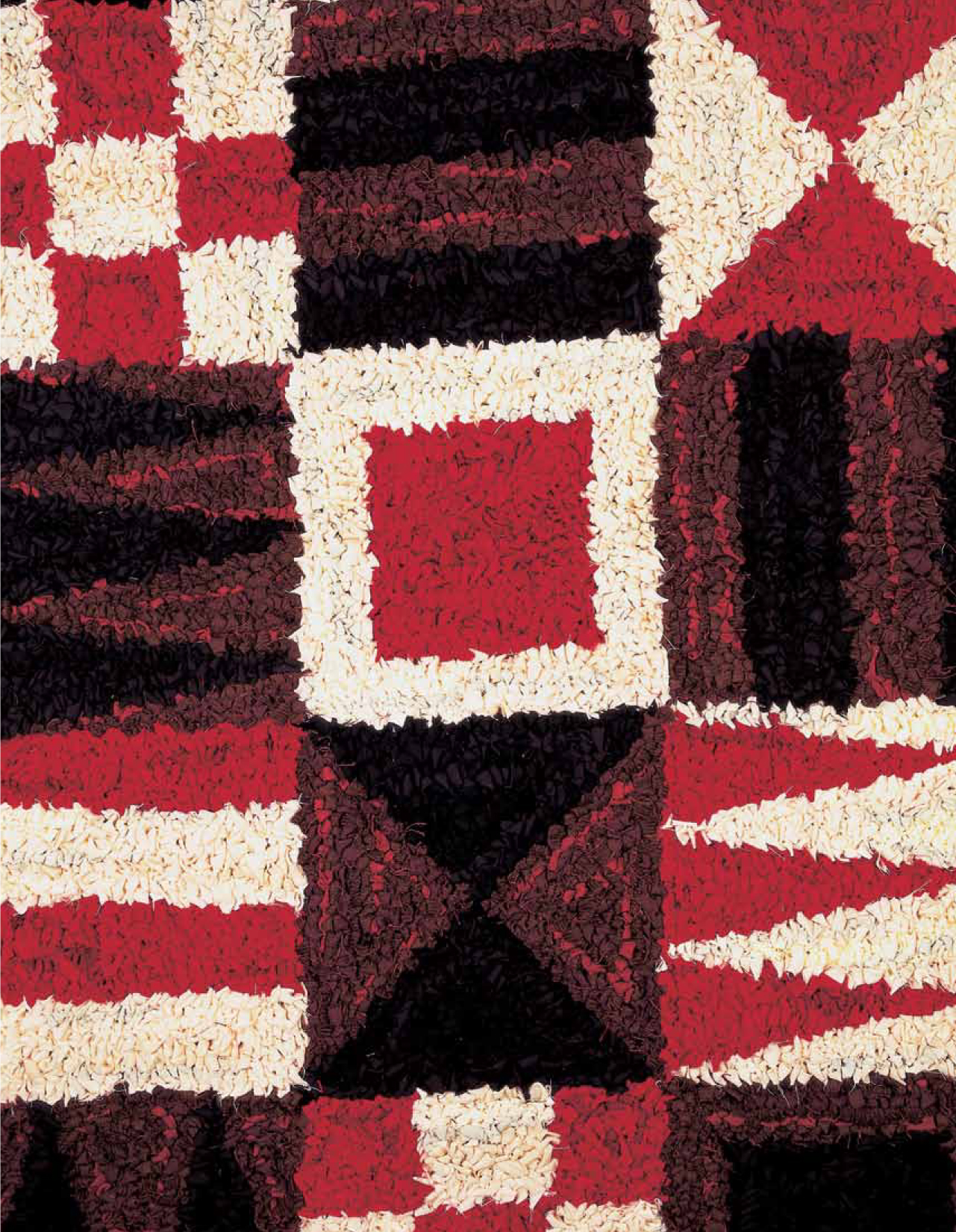
MATERIALS
M uch of the pleasure of making rag rugs comes from finding the materials. Fabrics that look unattractive in an old item of clothing are transformed when included in a rag rug. Rag materials are widely available and inexpensive, but it is impossible to predict what you will find; this is what makes each rug unique. Old clothes, household textiles and wrappings are all good sources. Fabrics that you can use include sweaters (particularly old shrunken ones in which the wool has felted), blankets, curtains, towels, nets, yarns, twisted newspaper, plastic bags, fur, feathers, candy wrappers, dresses, jackets, coats, T-shirts and socks.
While any material can be used in a rag rug, certain fabrics will make it easier to carry out the technique. Hooked rugs are easiest to make if the rag material has a lot of give and some loft; thus knitted fabrics are much easier to work than stiff, heavy fabrics. The best materials include T-shirts, wool sweaters, synthetic knits, lightweight cottons, nets and plastic bags. Heavy woven wools may also be suitable, but the rag strips need to be narrower. Very heavy, stiff fabrics like new denim are difficult to hook and are more suitable for prodded rugs, where a firm fabric is preferable. When making a braided rug avoid fabrics that fray easily and when selecting materials, bear in mind that the pattern on a fabric will be visible.

balls of rags.
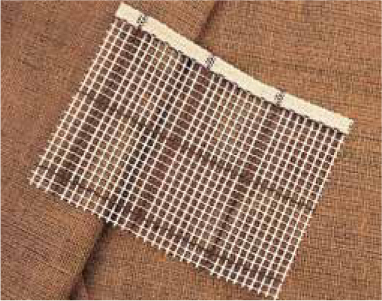
rug canvas and hessian.
QUANTITY OF RAG FABRIC
The amount of fabric needed to make a rug depends on the technique to be used, the thickness of the fabric and the length and density of the pile (if there is one). It is best to collect a wide variety of fabrics in your chosen colours, say a large bag full and to add more fabric if you need it as you work. If you are hooking or prodding a rug, you can work out a rough estimate of how much fabric you will need by cutting a 50 x 50cm (20 x 20in) piece of fabric that is typical of the type of fabric that you intend to use. Work the fabric square, then measure the worked patch and divide the size of the finished rug by the size of this patch. Multiply this number by 40 to arrive at the number of square centimetres of fabric you will need.

